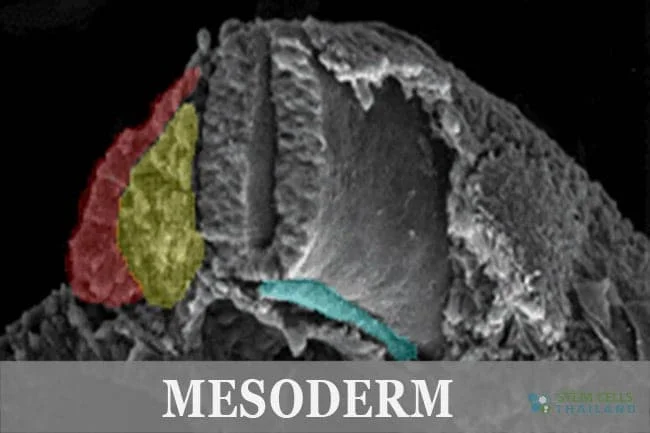
Mesoderm is the The middle part of the three germ layers and a derivative of a blastocyst inner cell mass. The mesodermal layer is composed of cells that have the ability to differentiate into muscle and bone cells, as well as kidney cells ,ligaments and connective tissues.[1]
Mesoderm specifically gives rise to the following structures and tissues:
During embryonic development, the mesoderm originates from the epiblast. Through a process called gastrulation, cells migrate inwards to form this middle germ layer. As development progresses, the mesoderm further differentiates and specializes to form the above-mentioned structures and tissues.
The proper formation and differentiation of the mesoderm are crucial for the development of a healthy embryo. Any disruptions or abnormalities in this process can lead to congenital malformations or developmental disorders.
For humans, the mesoderm is among the 3 primary germ cell layers. The other two germ layers are endoderm and the ectoderm. In the early stages of an embryo the mesoderm area is the central layer.The Mesoderm layer forms during gastrulation and lies between the ectoderm and the endoderm.[2]
It leads to development of some glands and also helps give rise to several other vital structures and tissues including cartilage,bone,connective tissue, muscle, blood for vascular system, reproductive,urinogenital and excretory systems. Stem cells in mesodermal tissues keep the ability to differentiate in varied ways. For instance, Bone marrow stem cells “mesoderm” can become liver cells “endoderm”.[3]
The mesoderm can be identified with 3 germ layers seen in the embryo of all “Bilaterian” creatures. That includes all creatures on Earth with the exception Cnidarians,Placozoans and sponges making them triploblastic. The NODAL indicator helps to mediate the initial formation of the mesoderm layer.
[1] ^ Phermthai, Tatsanee, Singpetch Suksompong, Nednapis Tirawanchai, Surapol Issaragrisil, Suphakde Julavijitphong, Suparat Wichitwiengrat, Decha Silpsorn, and Puttachart Pokathikorn. 2013. Epigenetic analysis and suitability of amniotic fluid stem cells for research and therapeutic purposes. Stem cells and development, no. 9 (February 12). doi:10.1089/scd.2012.0371. https://www.ncbi.nlm.nih.gov/pubmed/23249260
[2] ^ Noisa, Parinya, and Rangsun Parnpai. 2011. Technical challenges in the derivation of human pluripotent cells. Stem cells international (June 19). doi:10.4061/2011/907961. https://www.ncbi.nlm.nih.gov/pubmed/21776284
[3] ^ Moroz, Leonid L, Kevin M Kocot, Mathew R Citarella, Sohn Dosung, Tigran P Norekian, Inna S Povolotskaya, Anastasia P Grigorenko, et al. 2014. The ctenophore genome and the evolutionary origins of neural systems. Nature, no. 7503 (May 21). doi:10.1038/nature13400. https://www.ncbi.nlm.nih.gov/pubmed/24847885
Chimeric antigen receptor-T cell treatment (CAR-T cell therapy) holds immense potential to revolutionize organ transplantation, particularly for patients who struggle… Read More
In the ever-evolving landscape of nutrition science, the discourse around dietary fats has undergone significant transformation. The Regeneration Center is… Read More
New research shows that specific types of brain cells become active after brain injuries and exhibit properties similar to those… Read More
Chemokines, critical components in the immune system, are small proteins that facilitate the migration and positioning of immune cells throughout… Read More
Stem cell research examines everything from gene expression to differentiation capacities to therapeutic potentials. With such diverse data types and… Read More
Stem cell therapy has emerged as a revolutionary new treatment approach for neurological and spinal disorders. One up-and-coming method of… Read More